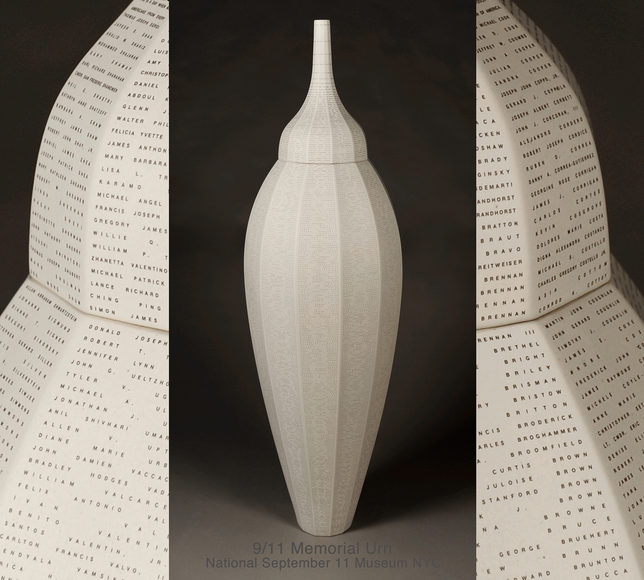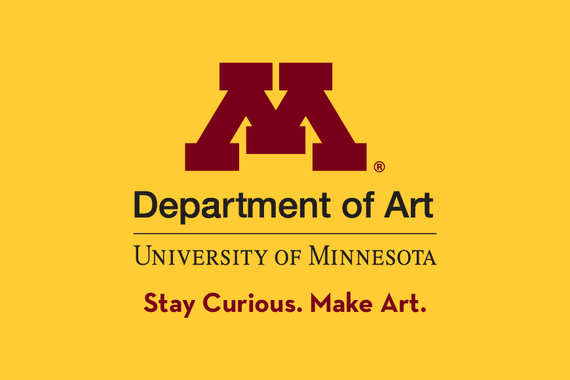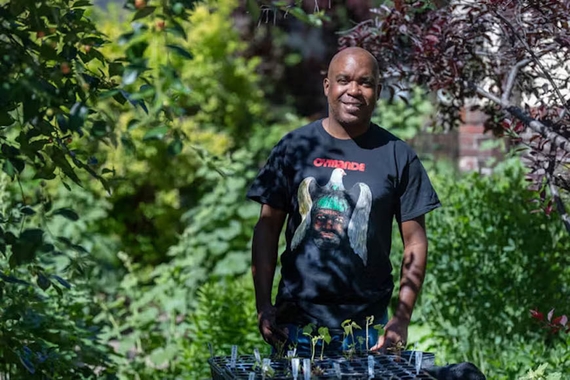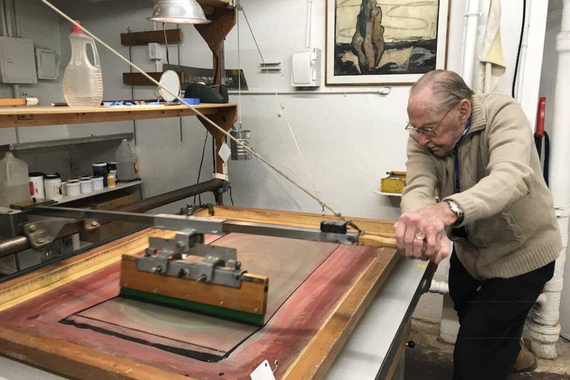Tom Lane Retiring from the Department of Art
If you were able to see Associate Professor Tom Lane’s recent retrospective show at the Katherine E. Nash Gallery, you likely came away with a good sense of the man: someone with a deep respect for the tradition and craft of ceramics – and someone who loves a good laugh.
Of course, if you’ve taken a class from him at any point in the past 44 years, you probably already knew that. A master of process, Tom is interested in moving the medium forward as new technologies develop, embracing various forms of digital technology including CAD, CNC, and Digital Ceramic Printing. Porcelain remains his primary medium, with which he has built a large body of conceptual vessels and sculptures that range from the satirical to the somber – most notably in his 9/11 Memorial Urn, which stands over four feet high and is part of the permanent collection of The National September 11 Museum in New York.

As Tom embarks on life as an Emeritus, we wanted to get some parting wisdom from him in the Q&A below. Please join us in thanking Tom for his service to this school and all of its students over the years, and in wishing him well in his next chapter!
Q&A with Associate Professor Tom Lane
Ceramics are a medium that date back millennia, so the span of a single career is really just a drop in the ocean of such a deep tradition, but I wonder if, even in just 44 years, you have seen any changes in the medium? How is being a ceramicist different now, technologically or culturally, from when you started out?
Ceramics, as seen from inside the discipline, has not changed much in the half century I have been making ceramic art. There is always new and exciting work being produced, but very little that has changed the direction of this big ship. Ceramic artists have always had to decide where in the spectrum of Fine Craft to Fine Art they belong. The Fine Craft artists have an allegiance to the material and in many cases the vessel as pottery or as art objects. The Fine Art ceramic artist is willing to use other materials and to explore issues that are more a part of the Fine Art community, especially the discipline of Sculpture.
The forming technologies in ceramics have expanded some with the use of 3D printing, but for the most part the potters wheel, hand building, and molds are still the foundation. Two dimensionally, digital printing for ceramics has expanded surface/image possibilities, but few artists have embraced this technology in comparison to conventional methods. The hand and the gesture of the clay is a big deal now. Most commercial galleries now represent ceramic artists. The spectrum of artistic sensibilities in ceramics is quite broad.
This year marks your retirement from a long career as an educator at the U of M. Are there any particular moments that stand out fondly in your memory from your time working here in the Department of Art?
The moments that I enjoy most about working in the Department of Art are seeing my students have breakthroughs in understanding art, conceptualizing art, and making art. The visual creative process is a fascinating area to discuss with students. They often think art should look a certain way, kind of shopping for an aesthetic. When they realize there is an infinite degree of freedom available to them, it blows their minds.
Equal to teaching is being an art researcher at an R1 university. In the art world, this is one of the best jobs on the planet. Patronage via salary, grants, and time allows for artistic possibilities to manifest, unencumbered. One of the most important projects of support in my career at the University of Minnesota was an Imagine Fund Grant that funded the making of the 9/11 Urn, a 56” high porcelain vessel with the names of the 2,977 victims of 9/11. This major work of art is in the Tribute Art Collection at the September 11th Memorial and Museum in NYC.
From a collegiality perspective, the simple things stand out the most. From 1977 to 1985, Warren MacKenzie and I taught on the same day in the basement of the old art building. We were in the habit of carrying bag lunches. Typically turkey sandwiches, carrot sticks, and a thermos of coffee, maybe an apple. After the food was gone, we talked, mostly about “Pots,” Warren’s favorite subject. As a young faculty, I was interested in Warren’s perspective on utilitarian pottery. He was a great storyteller. The stories seemed to change a bit over the years. His laughter never did.
Are there any lessons that you learned from your students, and more broadly, how did being an educator affect your own work as an artist?
I think the biggest lesson I have learned from my students is to practice what I preach. The art making practice is like a pendulum swinging. Our attention goes in. Our attention goes out. We gather momentum when we visit galleries and museums. We gather momentum when we develop our technical skills. We gather momentum when we read and think. All this momentum, when reversed, produces powerful results in the art we create.
Any words of wisdom for educators just starting out?
Good teaching expands the territory of influence of the student to the point of self-sufficiency. Students need to understand the context of knowledge in the technologies we teach, the aesthetic models we promote, and in the history of our discipline. Give assignments that are both specific and open. Design your assignments to build on skills in thinking and doing. Don’t tell them what to do. Give them the tools to find their own answers. Encourage your students to prepare well for the creative process. We seldom speak of the value of routine, eating well, and quality rest. Consider promoting self-improvement techniques like meditation and yoga. Well begun is half done.
What are you looking forward to most in your retirement? New hobbies, an urge to travel, or just more time in the studio?
In 2020, I built a studio on our property in rural Hudson, Wisconsin. I haven’t named it, maybe, “Heaven in Hudson.” To have time to access my creative self and make beautiful, thoughtful objects, is truly a blessing. What form the new work will take is always an interesting question. Come and see. You are all welcome.
You can keep up with Tom Lane on Instagram @tom_lane_ceramics. Lane has exhibited his work across the world, most notably at Hunter College, Brown University, The National September 11 Museum, Houston Center for Contemporary Crafts, Central Fine Arts Academy in Beijing, Genesee Gallery in Rochester, NY, Great China Museum in Jingdezhen, China, and, of course, the Katherine E. Nash Gallery here at Regis Center for Art.
Lane's work is included in the Collections of September 11 National Museum, New York, NY; Sanbao International Ceramic Art Museum, Jingdezhen City, Jiangxi Province, P.R. China;Timberwolves, Target Center, Minneapolis, MN; Weisman Art Museum, University of Minnesota, Minneapolis, MN; Albuquerque Museum, Albuquerque, NM; and Donna and Cargill MacMillan Collection, Indian Well, CA.



